Challenges of Promoting Sustainable Mobility on University Campuses: The Case of Eastern Mediterranean University
Abstract
:1. Introduction
- Outline and argue for the benefits of sustainable transportation within university campuses;
- Identify successful strategies for promoting the use of active modes of transportation;
- Isolate challenges related to existing active modes of transportation inside the Eastern Mediterranean University (EMU) campus;
- Collect input from university staff and students to ascertain and explain recommendations that increase the use of active modes of transportation inside university campuses; and
- Provide a planning framework towards achieving sustainable transportation on university campuses.
- What are the ways of enhancing usage levels of active modes of transportation inside university campuses?
- What are the determinative steps that must be considered to achieve an efficient, sustainable transportation sector within university campuses?
2. Literature Review
3. Materials and Methods
- -
- Is there any future plan to decrease commuting to the campus by private car?
- -
- Is there any program to improve the quality of services related to active modes of transportation inside the campus? How do you see the quality of services?
- -
- Is there any program to encouraging carpooling and vanpooling among students and staff?
- -
- Is there a Campus Planning Unit in the University?
- -
- How are the decisions about any development in campus being taken?
4. Introducing and Assessing EMU Campus’ Existing Quality of Services and Strategies Related to Active Modes of Transportation
5. Results
5.1. Quality of Services Related to Existing Sustainable Modes of Transportation
5.1.1. Quality of Services Related to Pedestrians
5.1.2. Quality of Services Related to Cycling
5.1.3. Quality of Services Related to Public Transportation
5.2. Management Strategies Related to Transportation Context of EMU
- -
- Assist the foreign EMU students and academic and administrative staff in adapting to the traffic rules and regulations of the Turkish Republic of Northern Cyprus (TRNC) by offering educational seminars.
- -
- Conduct research and organize symposiums, congress, and conferences on traffic problems.
- -
- Increase the awareness of people living in North Cyprus about the importance of traffic.
- -
- Establish links with organizations working on traffic safety both in North Cyprus and abroad.
6. Discussion and Recommendations
- ▪
- Provide a sustainable master plan (SMP) for the university campus., since having a master plan by considering all aspects of sustainability is main way, which a university expresses its vision for future development and utilization of campus environment.
- ▪
- Create a stable, sustainable transportation committee (STC) that has control and will make decisions about all aspects of transportation on the university campus, as well as undertake consistent efforts to promote sustainable transportation strategies by focusing on shifting to sustainable modes of transportation.
- ▪
- Design a University Sustainable Transportation Master Plan (U-STMP) and University Sustainable Urban Mobility Plan (U-SUMP) corresponding with a general sustainable master plan along with strategies and policies confirmed by the STC.
- ▪
- Increase the level of collaboration between the STC and local organizations, especially the municipality, to make decisions promoting successful sustainable transportation strategies between the university campus and the city to encouragement of active transportation.
- ▪
- Increase the level of collaboration between the university administration, STC, and governmental agencies in order to establish a price-control mechanism for public transportation modes and connect the university’s efforts to city’s projects in order to increase the efficiency of both.
- ▪
- Develop representation of students and staff within the STC to make better decisions and provide efficient strategies that meet their needs.
- ▪
- Provide a series of educational programs focusing on enhancing knowledge of students and staff about environmental, social, cultural and economic benefits of commuting by sustainable modes of transportation.
7. Conclusions
Author Contributions
Funding
Conflicts of Interest
Appendix A. Sample of Questionnaire
Appendix A.1. Personal Information
- 1-
- Gender: □ Male □ Female
- 2-
- What is your age group? □ Under 25 years □ 26 to 35 □ 36 to 45 □ 46 to 60 □ 61 and above
- 3-
- Country:
- 4-
- Nationality:
- 5-
- Are you a □ Student □ Staff
- 6-
- Which faculty/department are you studying at or a member of?
- 7-
- What is your field of study? (If you are a student)
- 8-
- What is your highest degree or level of study? (If you are a student)□ Undergraduate student □ Graduate student
- 9-
- How long have you been studying or working at the EMU?□ Less than 1 year □ 1 to 2 year □ 3 to 4 year □ More than 4 years
- 10-
- Where do you live?□ Area 1 (<1 Km from the EMU campus) □ Area 2 (1 < 5 Km from the EMU campus) □ Area 3 (>5 Km from the EMU campus)
- 11-
- What kinds of accommodation are you living in?□ Dormitory □ Shared flat □ Apartment □ Villa □ Other …..……….. (Please specify)
Appendix A.2. Modes of Transportation for Commuting within and from/to the Campus
- 1-
- What kind of transportation modes do you usually use for commuting to or from the campus?□ Private car □ Public transportation □ Bicycle □ Walking
- 2-
- What kind of transportation modes do you usually use to move from one place to another within the campus?□ Private car □ Public transportation □ Bicycle □ Walking
Appendix A.3. The Quality of Infrastructure and Service Related to Active Modes of Transportation inside EMU Campus
Appendix A.3.1. Quality of Services Related to Pedestrians
- 1-
- How do you see the continuity among pedestrian paths inside the campus?□ Poor □ Fair □ Good □ Excellent
- 2-
- What do you think about the condition and quality of pedestrian paths’ pavements?□ Poor □ Fair □ Good □ Excellent
- 3-
- What do you think about safety along the pedestrian paths?□ Poor □ Fair □ Good □ Excellent
- 4-
- What do you think about quality of lighting along pedestrian paths at nights?□ Poor □ Fair □ Good □ Excellent
- 5-
- How do you see the safety in interaction points between pedestrians and vehicles inside the campus?□ Poor □ Fair □ Good □ Excellent
- 6-
- How do you see the quality of pedestrian signage?□ Poor □ Fair □ Good □ Excellent
- 7-
- What do you think about the width of pedestrian paths?□ Poor □ Fair □ Good □ Excellent
- 8-
- What do you think about the quality of services for accessibility of disabled users?□ Poor □ Fair □ Good □ Excellent
- 9-
- How do you see the quality of crosswalks along the campus?□ Poor □ Fair □ Good □ Excellent
- 10-
- How do you see the quality of shadings elements along the pedestrian paths?□ Poor □ Fair □ Good □ Excellent
Appendix A.3.2. Quality of Services Related to Cycling
- How do you see the bike lane efficiency inside the EMU campus?□ Poor □ Fair □ Good □ Excellent
- What do you think about safety along bike-share lanes?□ Poor □ Fair □ Good □ Excellent
- What do you think about quality of bicycle parking and racks?□ Poor □ Fair □ Good □ Excellent
- What do you think about the quality of shading elements along the bike lanes?□ Poor □ Fair □ Good □ Excellent
- What do you think about the quality of showering facilities?□ Poor □ Fair □ Good □ Excellent
- What do you think about quality of repair and accessory facilities?□ Poor □ Fair □ Good □ Excellent
- What do you think about safety of bike parking and racks?□ Poor □ Fair □ Good □ Excellent
- How do you see the quality of signage for cyclists?□ Poor □ Fair □ Good □ Excellent
Appendix A.3.3. Quality of Services Related to Public Transportation
- What do you think about efficiency of bus services?□ Poor □ Fair □ Good □ Excellent
- What do you think about quality of bus shelters by focusing on number of shelters on the campus?□ Poor □ Fair □ Good □ Excellent
- What do you think about quality of bus shelters by focusing on location of shelters?□ Poor □ Fair □ Good □ Excellent
- What do you think about quality of lighting inside bus shelters?□ Poor □ Fair □ Good □ Excellent
- What do you think about quality of seating elements inside bus shelters?□ Poor □ Fair □ Good □ Excellent
- How do you see the existence of route/schedule information?□ Poor □ Fair □ Good □ Excellent
- What do you think about quality of bus signage?□ Poor □ Fair □ Good □ Excellent
- What do you think about the bus timing?□ Poor □ Fair □ Good □ Excellent
Appendix A.4. Personal Expectations and Suggestions
- 1-
- What is your expectation and suggestion for improving the service quality of pedestrian facilities?
- 2-
- What is your expectation and suggestion for improving the service quality of cycling facilities?
- 3-
- What is your expectation and suggestion for improving the quality of bus service?
- 4-
- Which type of active modes of transportation do you prefer to use if all facilities about it be in a good condition?
References
- Hickman, R.; Hall, P.; Banister, D. Planning more for sustainable mobility. J. Transp. Geogr. 2013, 33, 210–219. [Google Scholar] [CrossRef]
- Litman, T. Developing indicators for comprehensive and sustainable transport planning. J. Transp. Res. Board 2007, 2017, 10–15. [Google Scholar] [CrossRef]
- Qureshi, I.A.; Lu, H. Urban transport and sustainable transport strategies: A case study of Karachi, Pakistan. Tsinghua Sci. Technol. 2007, 12, 309–317. [Google Scholar] [CrossRef]
- Steg, L. Sustainable transportation a psychological perspective. IATSS Res. 2007, 31, 58–66. [Google Scholar] [CrossRef]
- Zuidgeest, M.H.P. Sustainable Urban Transport Development: A Dynamic Optimisation Approach; University of Twente: Enschede, The Netherlands, 2005. [Google Scholar]
- Babalik-Sutcliffe, E. Urban form and sustainable transport: Lessons from the Ankara case. J. Int. J. Sustain. Transp. 2013, 7, 416–430. [Google Scholar] [CrossRef]
- Prillwitz, J.; Barr, S. Moving towards sustainability? Mobility styles, attitudes and individual travel behaviour. J. Transp. Geogr. 2011, 19, 1590–1600. [Google Scholar] [CrossRef]
- Bayramoğlu, G. Planning and Design Criteria to Make Urban Transport More Sustainable: The Case of Baku; LAP LAMBERT Academic Publishing: Riga, Latvia, 2012. [Google Scholar]
- Cortese, A. Education for Sustainability: The University as a Model of Sustainability; Second Nature: Boston, MA, USA, 1999. [Google Scholar]
- Čiegis, R.; Gineitienė, D. The role of universities in promoting sustainability. Eng. Econ. 2006, 3, 56–62. [Google Scholar]
- Abubakar, I.R.; Al-Shihri, F.S.; Ahmed, S.M. Students’ assessment of campus sustainability at the University of Dammam, Saudi Arabia. Sustainability 2016, 8, 59. [Google Scholar] [CrossRef]
- Beringer, A. Campus sustainability audit research in Atlantic Canada: pioneering the campus sustainability assessment framework. Int. J. Sustain. High. Educ. 2006, 7, 437–455. [Google Scholar] [CrossRef]
- Guasch, C.; Domene, E. Sustainable transport challenges in a suburban university: The case of the Autonomous University of Barcelona. Transp. Policy 2010, 17, 454–463. [Google Scholar] [CrossRef]
- Limanond, T.; Butsingkorn, T.; Chermkhunthod, C. Travel behavior of university students who live on campus: A case study of a rural university in Asia. Transp. Policy 2011, 18, 163–171. [Google Scholar] [CrossRef]
- Xu, J.; Zhang, Z.; Rong, J. The campus road planning and design research. Procedia Soc. Behav. Sci. 2012, 43, 579–586. [Google Scholar] [CrossRef]
- Emanuel, R.; Adams, J.N. College students’ perceptions of campus sustainability. Int. J. Sustain. High. Educ. 2011, 12, 79–92. [Google Scholar] [CrossRef]
- Lidstone, L.; Wright, T.; Sherren, K. Canadian STARS-rated campus sustainability plans: Priorities, plan creation and design. Sustainability 2015, 7, 725–746. [Google Scholar] [CrossRef]
- ISCU. Best Practice in Campus Sustainability; The World Economic Forum Annual Meeting: Davos-Klosters, Switzerland, 2014. [Google Scholar]
- Velazquez, L.; Munguia, N.; Sanchez, M. Deterring sustainability in higher education institutions: An appraisal of the factors which influence sustainability in higher education institutions. Int. J. Sustain. High. Educ. 2005, 6, 383–391. [Google Scholar] [CrossRef]
- Fund, A.; Hall, A.; Gorby, C.; Siegel, D.; Wolf, E.; Burdett, J.; Gathunguri, M. Sustainable Transportation at the University of Kansas; Center for Sustainability University of Kansas: Lawrence, KS, USA, 2012. [Google Scholar]
- Norzalwi, N.; Ismail, A. Public Approach towards sustainable transportation in UKM’s campus. Aust. J. Basic Appl. Sci. 2011, 5, 1332–1337. [Google Scholar]
- Toor, W.; Havlick, S.W. Transportation and Sustainable Campus Communities; Island Press: Washington, DC, USA, 2004. [Google Scholar]
- Bond, A.; Steiner, R.L. Sustainable campus transportation through transit partnership and transportation demand management: A case study from the University of Florida. Berkeley Plan. J. 2006, 19, 125–142. [Google Scholar]
- Dehghanmongabadi, A.; Shirkhanloo, N. Questioning the contribution of higher education institutions to the cultural sustainability of local communities. In Proceedings of the People and the Planet 2013, Transforming the Future, Melbourne, Australia, 2–4 July 2013; pp. 1–12. [Google Scholar]
- Lim, C.C. The status of transportation demand management in Greater Vancouver and energy implications. Energy Policy 1997, 25, 1193–1202. [Google Scholar] [CrossRef]
- Litman, T. The online TDM encyclopedia: Mobility management information gateway. Transp. Policy 2003, 10, 245–249. [Google Scholar] [CrossRef]
- Senft, G. U-Pass at the University of British Columbia: Lessons for effective demand management in the campus context. Proceedings of Emerging Best Practices in Urban Transportation Planning (A) Session of the 2005 Annual Conference of the Transportation Association of Canada, Calgary, AB, Canada, 18–21 September 2005; pp. 1–21. [Google Scholar]
- Ferguson, E. Transportation demand management planning, development, and implementation. J. Am. Plan. Assoc. 1990, 56, 442–456. [Google Scholar] [CrossRef]
- Berman, W.; Radow, L. Travel demand management in the USA: Context, lessons learned and future directions. Energy Policy 1997, 25, 1213–1215. [Google Scholar] [CrossRef]
- Litman, T.; Burwell, D. Issues in sustainable transportation. Int. J. Glob. Environ. Issues 2006, 6, 331–347. [Google Scholar] [CrossRef]
- Aoun, A.; Abou-Zeid, M.; Kaysi, I.; Myntti, C. Reducing parking demand and traffic congestion at the American University of Beirut. Transp. Policy 2013, 25, 52–60. [Google Scholar] [CrossRef]
- Litman, T. Mobility Management: Innovative Management Strategies to Transport Problems; Victoria Transport Policy Institute: Victoria, BC, Canada, 2006. [Google Scholar]
- Azzali, S.; Sabour, E.A. A framework for improving sustainable mobility in higher education campuses: The case study of Qatar University. Case Stud. Transp. Policy 2018, 6, 603–612. [Google Scholar] [CrossRef]
- Bowman, A. “You can get there from here”: Campus transportation practices: What they are, and what they could be. Coastlines 2018, 1, 5. [Google Scholar]
- Erdoğan, S.; Cirillo, C.; Tremblay, J.-M. Ridesharing as a green commute Alternative: A campus case study. Int. J. Sustain. Transp. 2015, 9, 377–388. [Google Scholar] [CrossRef]
- Balsas, C.J.L. Sustainable transportation planning on college campuses. Transp. Policy 2003, 10, 35–49. [Google Scholar] [CrossRef]
- Hickman, R.; Lopez, N.; Cao, M.; Lira, B.M.; Biona, J.B.M. “I drive outside of peak time to avoid traffic jams—Public transport is not attractive here.” Challenging discourses on travel to the university campus in Manila. Sustainability 2018, 10, 1462. [Google Scholar] [CrossRef]
- Brown, J.; Hess, D.B.; Shoup, D. Fare-free public transit at Universities. J. Plan. Educ. Res. 2003, 23, 69–82. [Google Scholar] [CrossRef]
- Karanikola, P.; Panagopoulos, T.; Tampakis, S.; Tsantopoulos, G. Cycling as a smart and green mode of transport in small touristic cities. Sustainability 2018, 10, 268. [Google Scholar] [CrossRef]
- Murwadi, H.; Dewancker, B. Study of Quassessment Model for campus pedestrian ways, case study: Sidewalk of the University of Lampung. Sustainability 2017, 9, 2285. [Google Scholar] [CrossRef]
- Killingsworth, R.E.; De Nazelle, A.; Bell, R.H. A New Role for Public Health in Transportation Creating and Supporting Community Models for Active Transportation; University of North Carolina: Chapel Hill, NC, USA, 2003. [Google Scholar]
- Lovasi, G.S.; Schwartz-Soicher, O.; Neckerman, K.M.; Konty, K.; Kerker, B.; Quinn, J. Aesthetic Amenities and Safety Hazards Associated with Walking and Bicycling for Transportation in New York City. Ann. Behav. Med. 2013, 45, 76–85. [Google Scholar] [CrossRef] [PubMed]
- Freeman, L.; Neckerman, K.; Schwartz-Soicher, O.; Quinn, J.; Richards, C.; Bader, M.D.M.; Lovasi, G.; Jack, D.; Weiss, C.; Konty, K.; et al. Neighborhood walkability and active travel (walking and cycling) in New York City. J. Urban Health 2013, 90, 575–585. [Google Scholar] [CrossRef] [PubMed]
- Basu, S.; Vasudevan, V. Effect of bicycle friendly roadway infrastructure on bicycling activities in urban India. Procedia-Soc. Behav. Sci. 2013, 104, 1139–1148. [Google Scholar] [CrossRef]
- Pucher, J.; Dill, J.; Handy, S. Infrastructure, programs, and policies to increase bicycling: An international review. Prev. Med. 2010, 50, S106–S125. [Google Scholar] [CrossRef] [PubMed]
- Snizek, B.; Nielsen, T.A.S.; Skov-Petersen, H. Mapping bicyclists’ experiences in Copenhagen. J. Transp. Geogr. 2013, 30, 227–233. [Google Scholar] [CrossRef]
- Zainal, Z. Case study as a research method. J. Kemanus. Bil 2007, 9, 1–6. [Google Scholar]
- Yin, R.K. Applications of Case Study Research; SAGE: Los Angeles, CA, USA, 2011. [Google Scholar]
- Banks, M. Visual Methods in Social Research; Sage Publications Inc.: New York, NY, USA, 2001. [Google Scholar]
- Gill, P. Framing a Complete Streets Checklist for Downtown Historic Districts and Character Neighbourhoods: A Case Study of the Warehouse District, Winnipeg, Manitoba; The University of Manitoba: Winnipeg, MB, Canada, 2014. [Google Scholar]
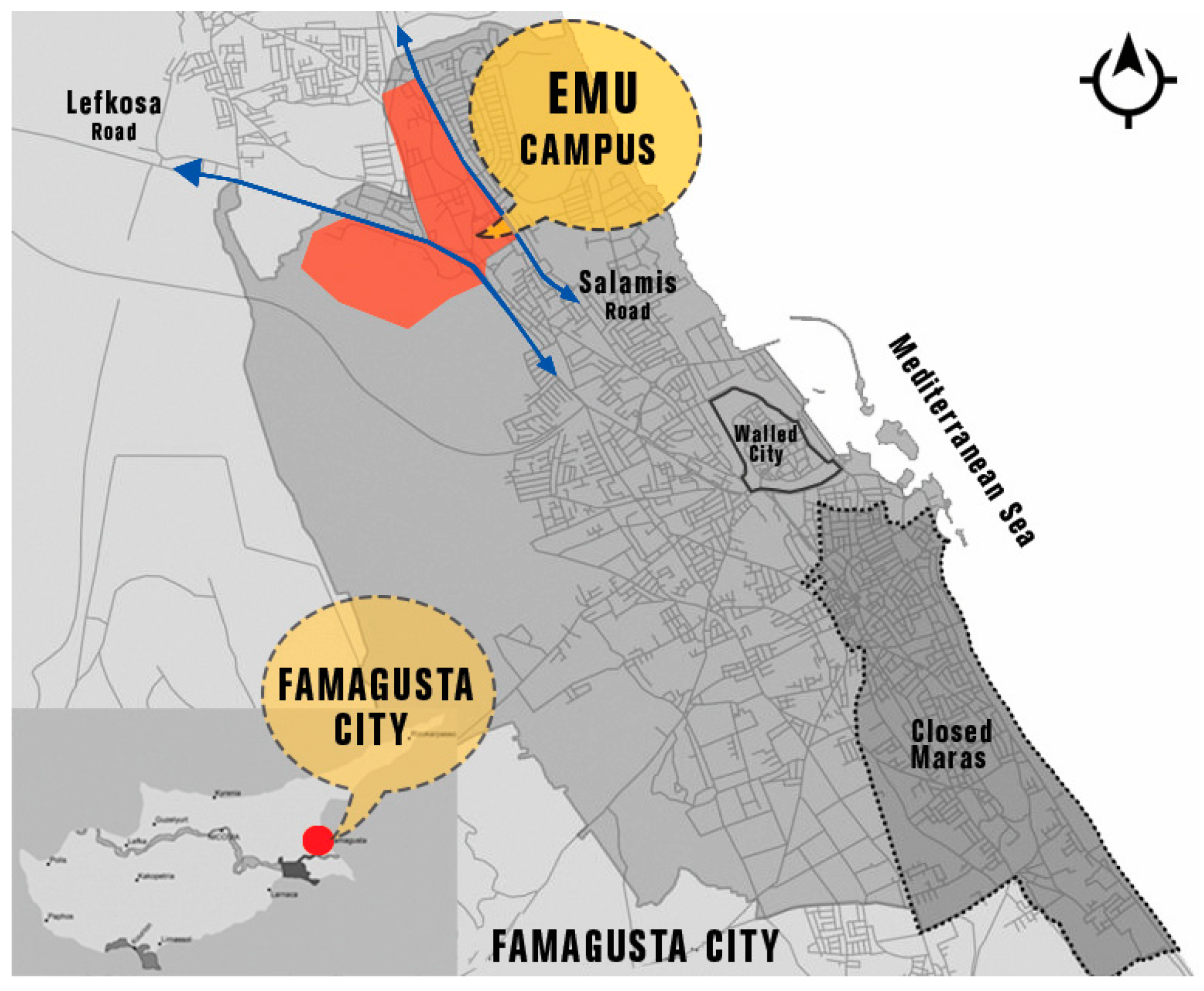


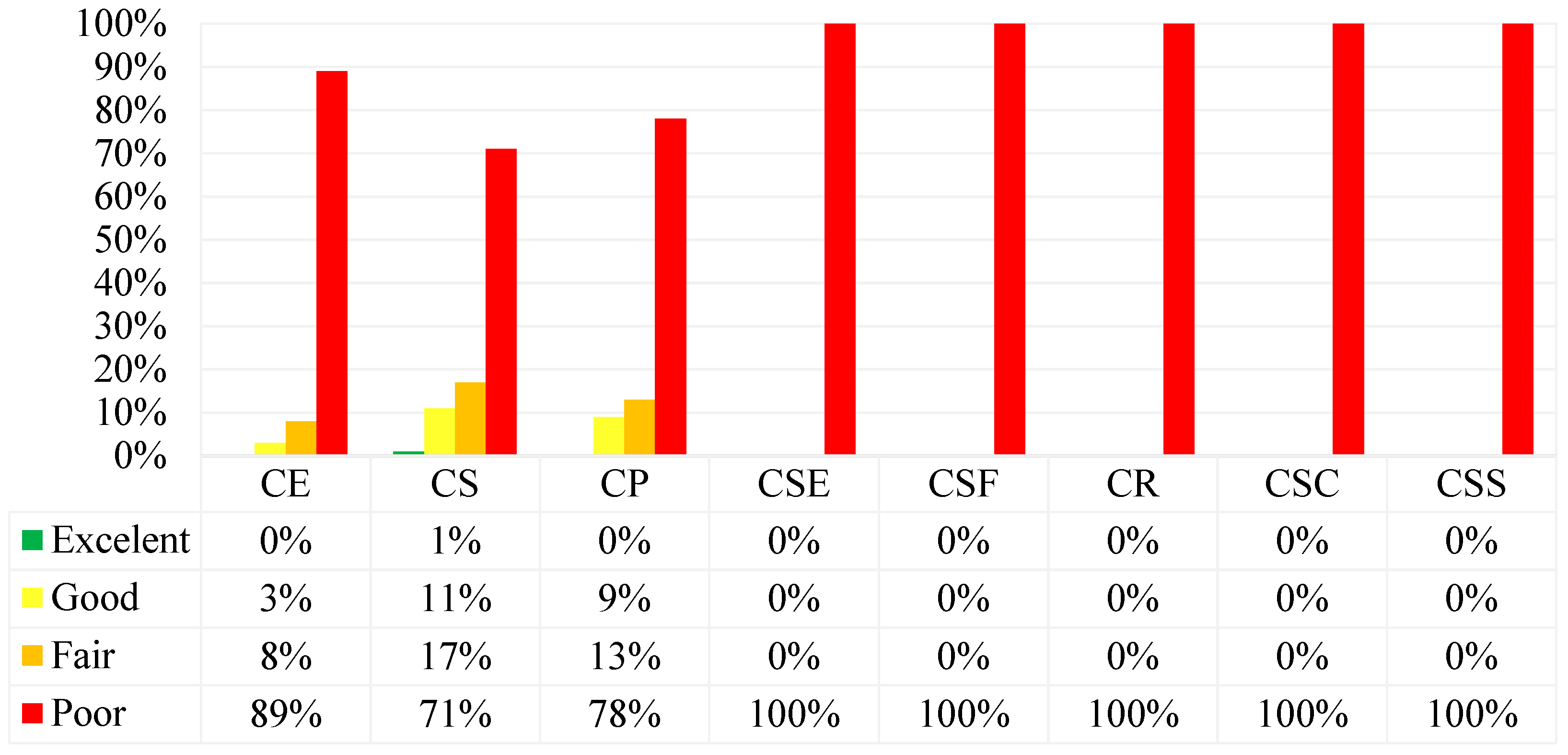
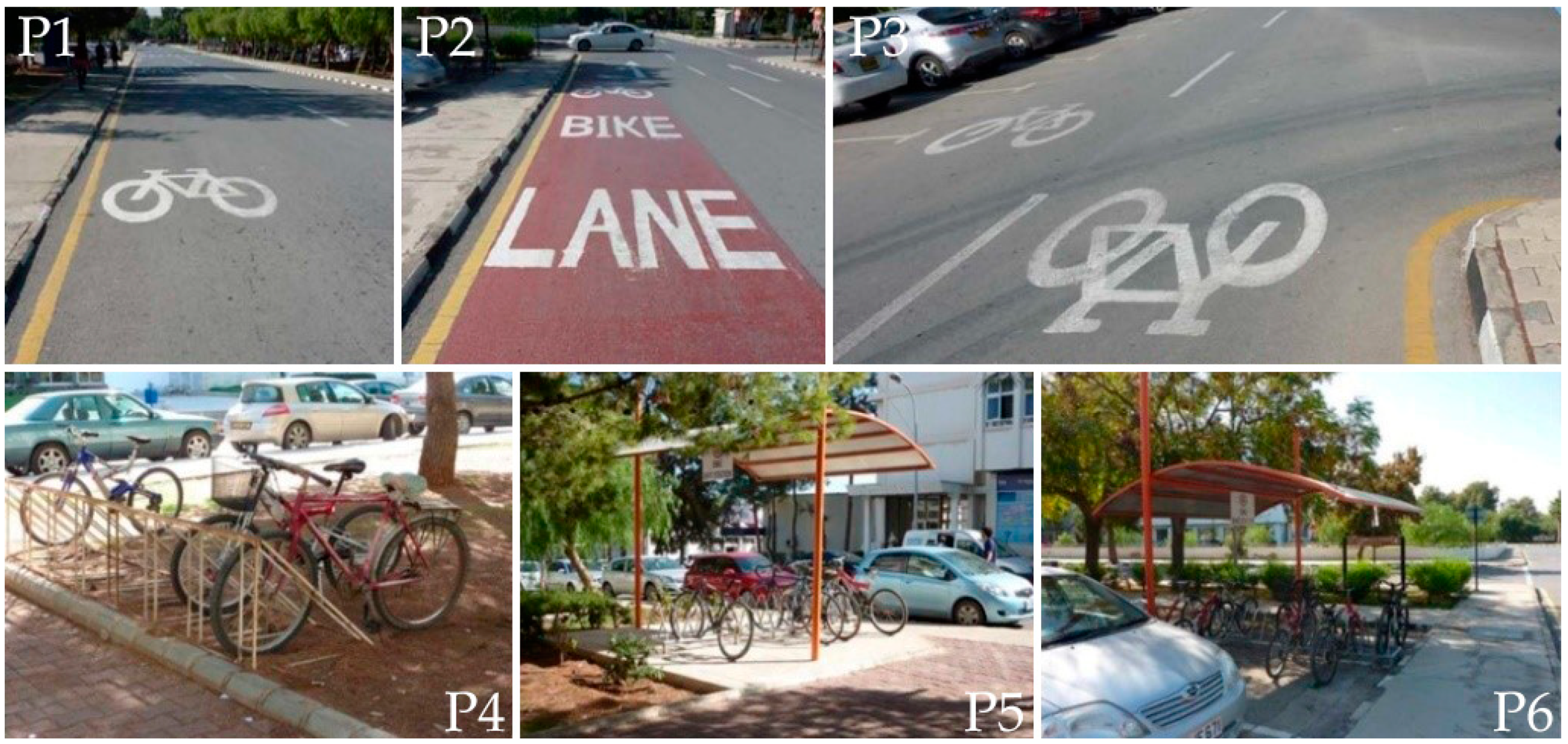
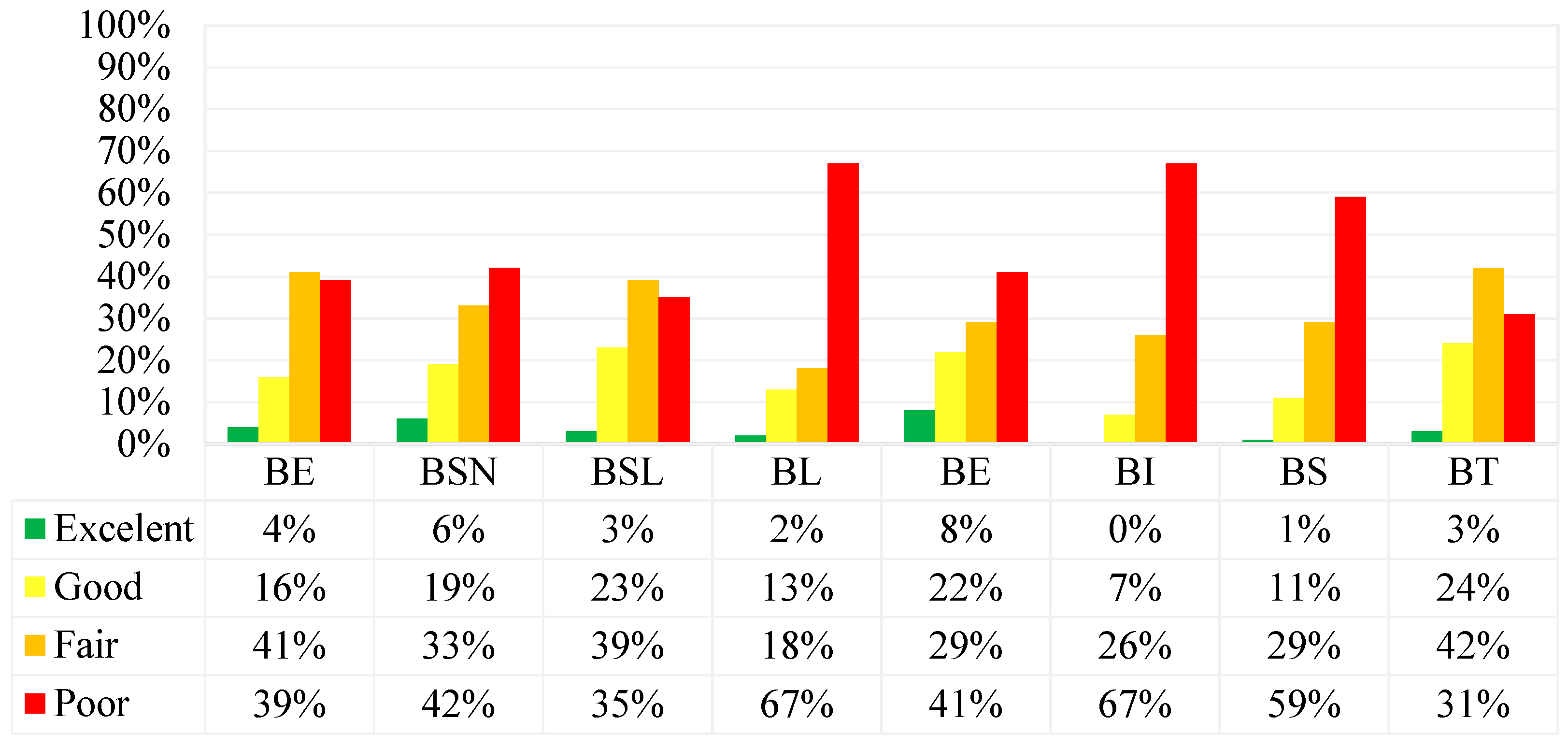
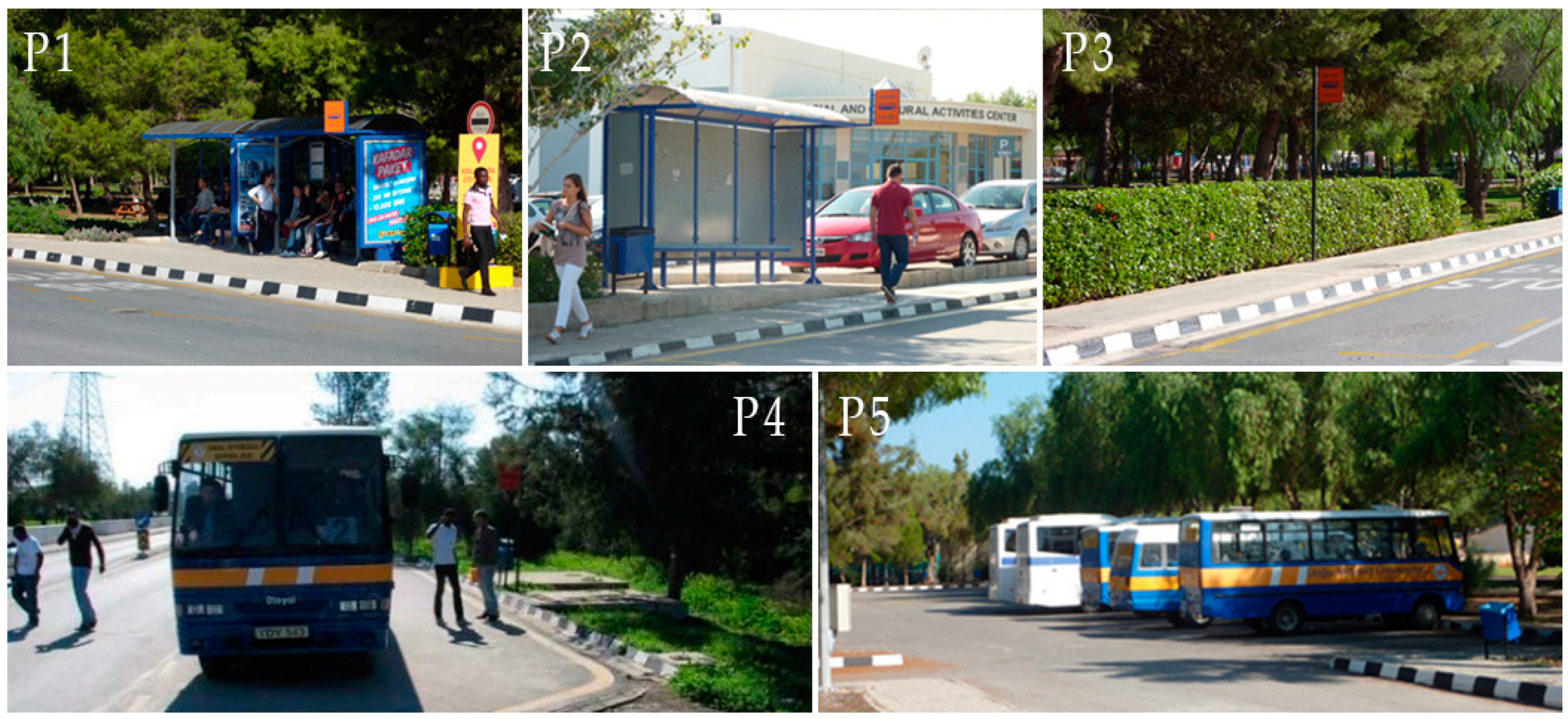
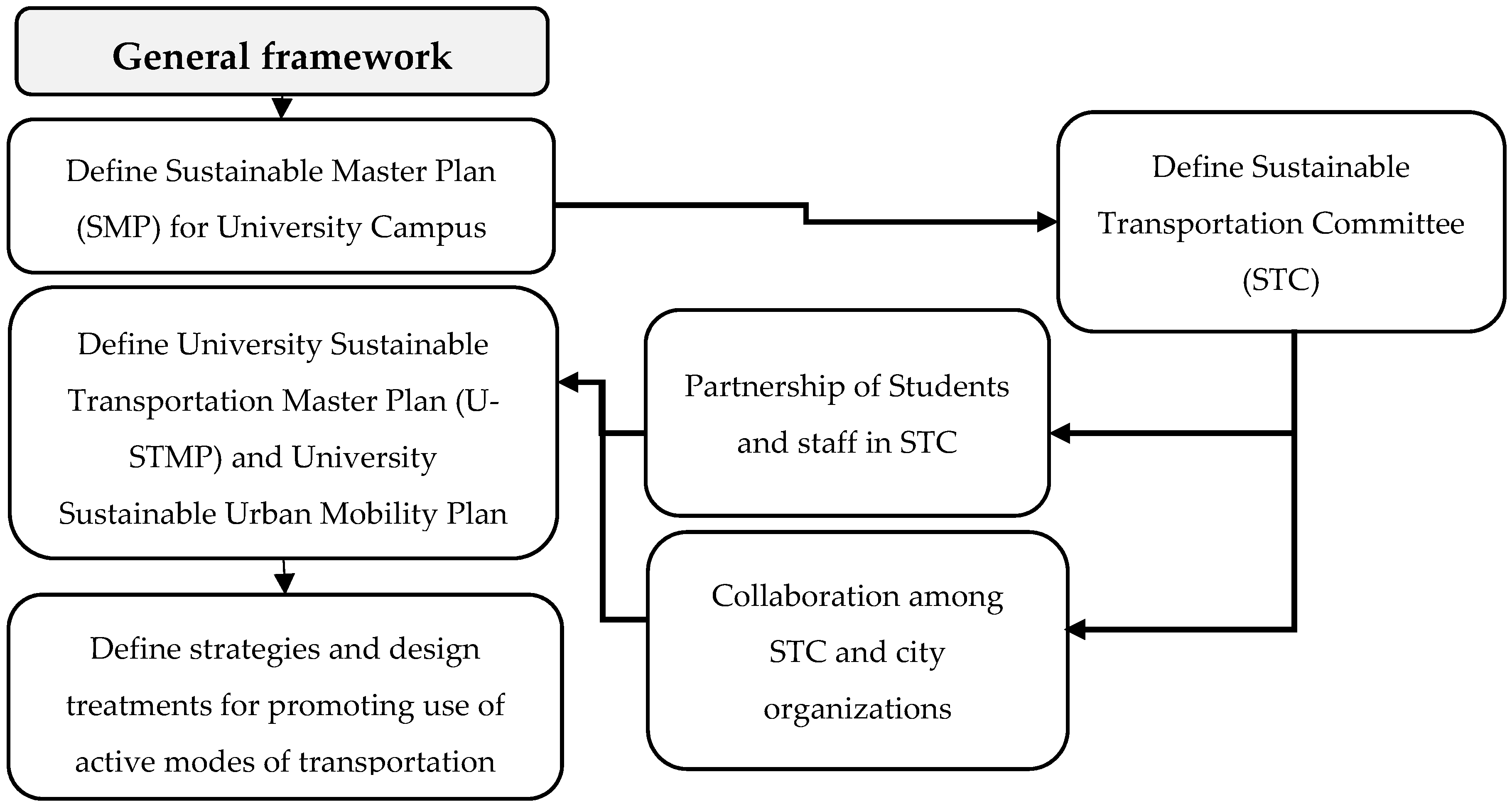
| Strategies | Factors | References |
|---|---|---|
Parking Management and Utilization
| - | [23,26,30] |
| Carpooling and Vanpooling | - | [22,35,36] |
| Public Transportation |
| [18,20,21,22,23] |
| Promoting Bicycle Use |
| [22,36,42,43,44,45,46] |
| Creating a Pedestrian Friendly Campus |
| [22,34,41,42] |
| Characteristic | Staff | Students | |||
|---|---|---|---|---|---|
| N | Sample (%) | N | Sample (%) | ||
| Gender | |||||
| 1 | Female | 101 | 51.8 | 275 | 47 |
| 2 | Male | 94 | 48.2 | 310 | 53 |
| Age group | |||||
| 1 | Under 25 years | - | - | 378 | 64.6 |
| 2 | 26–35 years | 24 | 12.3 | 207 | 35.4 |
| 3 | 36–45 years | 65 | 33.3 | - | - |
| 4 | 46–60 years | 100 | 51.3 | - | - |
| 5 | 61 and above | 6 | 3.1 | - | - |
| Location of living | |||||
| 1 | Area 1 (< 1 Km from the EMU campus) | 0 | 0 | 396 | 67.7 |
| 2 | Area 2 (1 < 5 Km from the EMU campus) | 92 | 47.17 | 167 | 28.5 |
| 3 | Area 3 (> 5 Km from the EMU campus) | 103 | 52.83 | 22 | 3.8 |
| Modes | Commuter Category | Commute between Campus and City | Commuting inside Campus |
|---|---|---|---|
| Pedestrian | Staff | 1% | 60% |
| Students | 47% | 80% | |
| Bicycle | Staff | 0% | 0% |
| Students | 8% | 5% | |
| Public Transport | Staff | 2% | 0% |
| Students | 29% | 7% | |
| Private Cars | Staff | 97% | 40% |
| Students | 16% | 8% |
| Motivators | Barriers | |
|---|---|---|
| Pedestrian |
|
|
| Cycling | No Motivators |
|
| Public Transportation |
|
|
| Management strategies | No Motivators |
|
| Measures | ||
|---|---|---|
| Pedestrian Enhancements |
|
|
|
| |
|
| |
|
| |
|
| |
| Cycling Enhancements |
|
|
|
| |
|
| |
| Public Transportation Enhancements |
|
|
|
| |
© 2018 by the authors. Licensee MDPI, Basel, Switzerland. This article is an open access article distributed under the terms and conditions of the Creative Commons Attribution (CC BY) license (http://creativecommons.org/licenses/by/4.0/).
Share and Cite
Dehghanmongabadi, A.; Hoşkara, Ş. Challenges of Promoting Sustainable Mobility on University Campuses: The Case of Eastern Mediterranean University. Sustainability 2018, 10, 4842. https://doi.org/10.3390/su10124842
Dehghanmongabadi A, Hoşkara Ş. Challenges of Promoting Sustainable Mobility on University Campuses: The Case of Eastern Mediterranean University. Sustainability. 2018; 10(12):4842. https://doi.org/10.3390/su10124842
Chicago/Turabian StyleDehghanmongabadi, Abolfazl, and Şebnem Hoşkara. 2018. "Challenges of Promoting Sustainable Mobility on University Campuses: The Case of Eastern Mediterranean University" Sustainability 10, no. 12: 4842. https://doi.org/10.3390/su10124842
APA StyleDehghanmongabadi, A., & Hoşkara, Ş. (2018). Challenges of Promoting Sustainable Mobility on University Campuses: The Case of Eastern Mediterranean University. Sustainability, 10(12), 4842. https://doi.org/10.3390/su10124842




